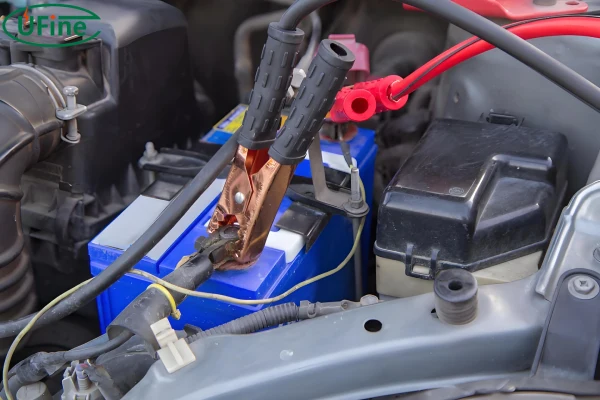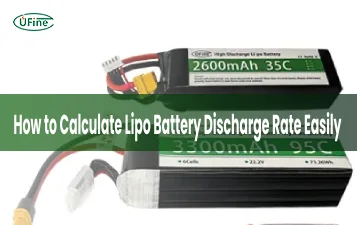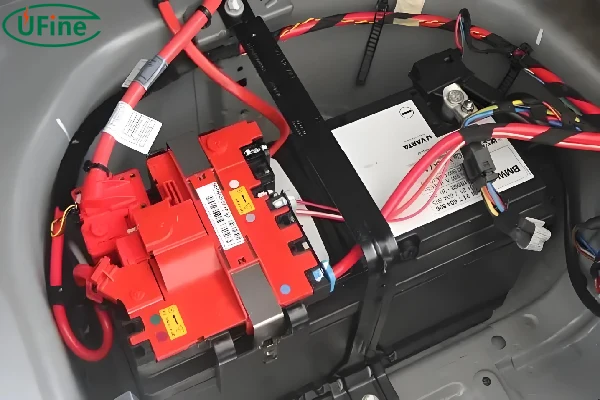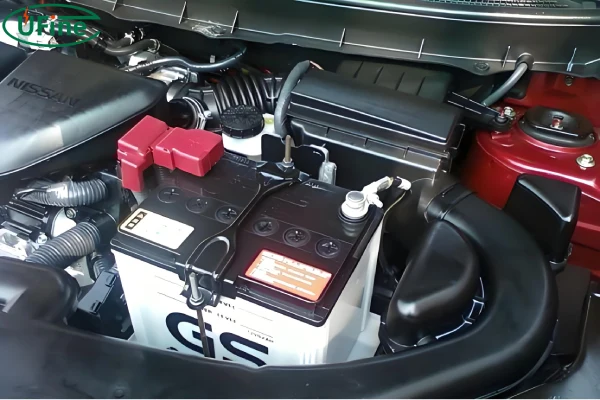Choosing the right car battery can feel like navigating a maze, especially with so many options out there. But don’t worry; we’re here to break down everything you need to know about car battery types, how to identify them, and their voltage, size, and key parameters. By the end of this guide, you’ll be a car battery expert, ready to make the best choice for your vehicle.
Part 1. Car battery types

When it comes to car battery types, you have several choices. Each type has its own set of benefits and is suited to different needs and preferences. Let’s take a closer look at the main types:
- Flooded Lead-Acid Batteries: These are your classic car batteries. They’ve been around for ages and are the most common type. You’ll recognize them by their removable caps, which are used for maintenance. Yes, they do require a bit of TLC, like checking and topping up with distilled water regularly. But they are quite affordable and get the job done for most standard vehicles.
- Absorbent Glass Mat (AGM) Batteries: If you’re looking for something a bit more advanced, AGM batteries might be your go-to. These batteries are completely sealed and maintenance-free, which means no more checking water levels. They provide better performance and have a longer lifespan compared to flooded batteries. They are a great choice for vehicles with higher electrical demands, like those with a lot of electronic features.
- Gel Cell Batteries: These are similar to AGM batteries but use a gel electrolyte instead of a liquid one. This makes them maintenance-free as well, and they offer good performance, especially in deep-cycle applications. They are less common but are well-suited for specific needs, such as in marine and recreational vehicles.
- Lithium-Ion Batteries: These are the new kids on the block. They are much lighter than their lead-acid counterparts and offer a significantly longer lifespan. However, they come with a higher price tag. Lithium-ion batteries are often used in high-performance and electric vehicles due to their efficiency and longevity.
Part 2. How to identify the car battery type?
Figuring out what type of battery your car uses is pretty important, especially when it comes to maintenance and replacement. Here are some handy tips to help you identify the type of battery you have:
- Check the Label: The simplest way to identify your battery type is to look at the label. It usually provides detailed information about the type, voltage, and capacity. Most manufacturers make it easy to find this info.
- Inspect the Battery: Take a close look at your battery. Flooded lead-acid batteries have telltale removable caps, while AGM and Gel Cell batteries are sealed. If you see a sleek, small, and light battery, it’s likely a lithium-ion.
- Consult the Manual: Your vehicle’s owner manual is a treasure trove of information. It will specify the recommended battery type for your car. This is a foolproof way to ensure you’re looking at the right battery.
- Ask a Professional: When in doubt, ask a mechanic or a battery specialist. They deal with batteries day in and day out and can quickly identify the type of battery you have.
Part 3. Car battery voltage
Voltage is a key factor in car batteries. Most car batteries are 12 volts, but there’s a bit more to it than just that. Let’s break it down:
- Fully Charged Battery: A fully charged 12-volt battery should read around 12.6 to 12.8 volts. This is the ideal range for a healthy battery.
- Partially Charged Battery: If your battery reads 12.4 volts, it’s about 75% charged. A reading of 12.2 volts indicates the battery is roughly 50% charged. Keeping an eye on these numbers can help you maintain your battery’s health.
- Discharged Battery: A reading below 12 volts means your battery is discharged. This is a red flag that it needs recharging or possibly replacement. Driving with a discharged battery can lead to starting problems and other electrical issues.
Understanding your battery’s voltage is essential. It helps you diagnose potential issues and ensures your battery operates correctly.
Part 4. Car battery size
Car batteries come in various sizes, and picking the right one is crucial. The size is typically specified by the Battery Council International (BCI) group number, which standardizes the dimensions of the battery. Here’s what you need to know:
- BCI Group Number: This number indicates the battery’s dimensions. For example, a Group 35 battery measures approximately 9.1 inches in length, 6.9 inches in width, and 8.9 inches in height. Knowing the BCI group number helps ensure you get a battery that fits perfectly in your car’s battery tray.
- Fitment: It’s vital to ensure the battery fits snugly in the battery tray. An incorrect size can cause installation issues and affect performance. A battery that’s too loose can move around and cause damage, while one that’s too tight might not fit at all.
- Terminal Location: The position of the positive and negative terminals can vary. Make sure the terminal locations match your vehicle’s requirements to avoid any connection issues. Some batteries have top-mounted terminals, while others have side-mounted terminals.
Part 5. Car battery key parameters
Several key parameters determine a car battery’s performance. Understanding these will help you choose the right battery for your needs. Here are the most important ones:
- Cold Cranking Amps (CCA): This measures the battery’s ability to start an engine in cold temperatures. A higher CCA rating is better for colder climates. For instance, if you live somewhere with harsh winters, a battery with a high CCA rating will ensure your car starts reliably.
- Reserve Capacity (RC): This indicates how long the battery can run your car’s electrical systems if the alternator fails. A higher RC means longer durability. This is particularly important if you have a lot of electronic features in your car that require power in the event of an alternator failure.
- Ampere-Hours (Ah): This measures the battery’s capacity to store energy. It tells you how long the battery can provide power before needing a recharge. A higher Ah rating means more stored energy and longer operating times.
Part 6. Which battery is suitable for my car?
Selecting the right battery for your car involves a few considerations. Here’s a step-by-step guide to help you make the best choice:
- Check the Owner’s Manual: Start by consulting your vehicle’s manual. It will specify the recommended car battery type, size, and parameters. This is your best bet for finding a battery that will fit perfectly and perform reliably.
- Consider Your Driving Conditions: Think about where you live and how you drive. If you’re in a cold climate, choose a battery with a high CCA rating for reliable starts in freezing temperatures. For hot climates, a battery with a high RC is better as it handles heat more effectively.
- Evaluate Your Vehicle’s Electrical Demands: Modern cars with advanced electronics and accessories require batteries with higher capacities. If your car has features like GPS, infotainment systems, and numerous other electronics, an AGM or lithium-ion battery might be the best choice.
- Budget Considerations: While AGM and lithium-ion batteries offer better performance and longevity, they come with a higher price tag. Flooded lead-acid batteries are more affordable but require regular maintenance. It’s essential to balance performance with your budget when making a decision.
- Brand and Warranty: Choose a reputable brand and check the warranty. A longer warranty period often indicates better quality and reliability. Well-known brands with good reviews are usually a safer bet.
When buying a car battery, pay attention to these factors to ensure you get the best performance and longevity. It’s not just about picking the most expensive or the most popular option; it’s about finding the one that suits your car and your needs perfectly.
In conclusion, understanding car battery types, how to identify them, and their key parameters is essential for maintaining your vehicle’s health. By knowing the voltage, size, and important features like CCA and RC, you can make an informed decision. Always consider your driving conditions, vehicle’s electrical demands, and budget when choosing a battery. With this guide, you’re now equipped to select the best battery for your car, ensuring it runs smoothly and reliably. So, next time you’re in the market for a new battery, you’ll know exactly what to look for and why.
Read More
How to Check Car Battery Life?
LiFePO4 Car Battery vs. Lead Acid Batterry: Pros and Cons Comparison
Related Tags:
More Articles

LiPo Battery Discharge Rate Guide & Calculation Tips
Understand LiPo battery discharge rates, C-ratings, and how to calculate max current. Essential guide for RC, drones, and electronics users.
High‑Capacity 3S LiPo Batteries: 5000 mAh vs. 10000 mAh
Compare 3S LiPo 5000mAh vs 10000mAh batteries by weight, power, and use. Find the best fit for your drone, RC car, or boat setup.
Top 5 Applications for Small 3S LiPo Batteries
Small 3S LiPo batteries power drones, RC gear, wearables, and robotics with high energy and low weight. Making them ideal for compact electronics projects.
Building and Charging Your Own 3S LiPo Pack: A Step‑by‑Step Guide
Learn how to build, balance, and charge a 3S LiPo battery pack safely at home with this complete DIY guide for hobbyists and beginners.
How to Choose the Right LiPo Battery Plug Type?
Discover the best LiPo battery plug types, how to choose them, and expert tips for safe usage, soldering, and maintenance.





